In today’s Profile, Merics researcher Nis Gruenberg talks about a vision from 2004 of what the future might look like if China was an economic power – an abstract idea at the time. 18 years later, that vision is now taking shape. Politically, however, increasingly sharp lines of conflict are emerging in the wake of China’s growing significance. These have the potential to tear open wounds that could destroy global peace.
And yet, governments are doomed to work closely together in this constellation. Namely, when it comes to the fight against global warming. If the climate tips over the critical threshold, there will only be losers anyway. However, countries wait and see what price the others are willing to pay in the form of declining economic growth.
In China, this tactic has a special dimension because the government has to reconcile growth with environmental and climate protection more urgently than in other countries, as Nico Beckert reports. If growth is curbed too much, social divisions threaten the rule of the CP. If too much carbon continues to be blown into the air, the climate will heat up even more. Extreme weather such as heat waves, floods and droughts would deprive China of its livelihoods. Harvests would be endangered and protests could be expected because the government failed to protect the people from disaster.
The recent past has already shown that political stability takes precedence over climate protection in China. What this means for the world is only an abstract idea today. But we will probably have a much more concrete idea of the consequences in 18 years’ time.

After last year’s coal crisis, climate change strikes this year and affects the power supply in some Chinese provinces. Factories are at a standstill, crops are at risk, and tens of millions of people are suffering under heat that can last for weeks (China.Table reported). Beijing leaders are facing one of the biggest challenges of the 21st century: How to reduce the massive carbon emissions of the Chinese economy without jeopardizing economic growth and jobs.
The lfW event “Green Growth: What can we expect from China?” explored this question. It quickly became clear what a dilemma the government is in: China must reconcile growth with environmental and climate protection. If growth is curbed too much, social divisions will threaten the rule of the CP. If too much carbon dioxide continues to be blown into the air, the climate will heat up even more. Extreme weather such as heat waves, floods and droughts would deprive China of its livelihoods. Harvests would be endangered and protests could be expected because the government failed to protect the people from disaster.
This poses a challenge for the People’s Republic to quickly decouple growth from carbon emissions, says Sebastian Eckardt, an economist at the World Bank. No country in history has had to transform its economy as quickly as China must now. Continued consumption of coal and other fossil fuels would plunge the world into climate chaos.
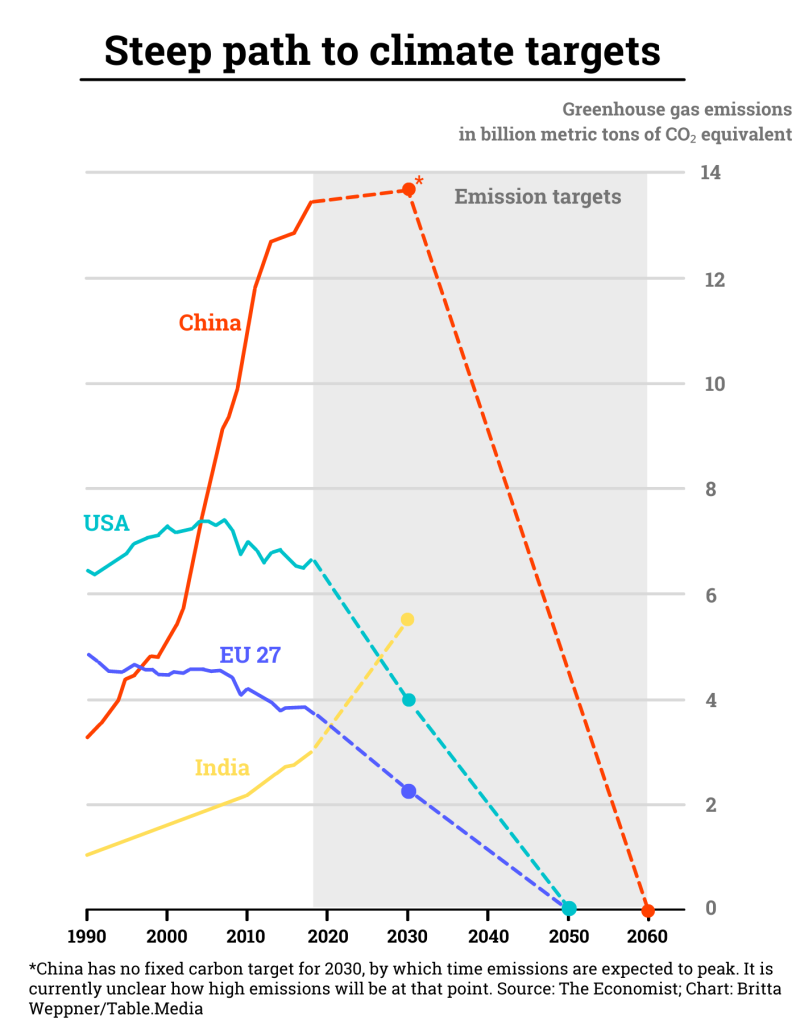
Eckardt sees two major problems here. First, he says, it is still difficult to reduce emissions in some industrial sectors – especially cement, iron and steel. According to Eckhardt, the necessary low-carbon production technologies are simply not yet available. Which has all the more impact on the climate because China’s industrial sector emits far more than either the US or the EU. Here, China could benefit from the fact that demand for construction raw materials will fall in the coming years, according to the World Bank expert. Other analysts assume that a lot of carbon dioxide can be saved in the next few years through scrap metal recycling (China.Table reported).
A second pressing problem is the social issue of decarbonization. According to various estimates, up to five million people work in coal production. The construction sector employs between 54 and 60 million people (China.Table reported). Should these jobs disappear, China’s social stability could be shaken. This is because, according to World Bank economist Eckardt, a switch to clean energy would primarily hurt unskilled, male workers. Getting these workers into new jobs poses immense challenges for the government. Regional inequality could rise sharply. After all, the necessary social systems to cushion unemployment are still lacking.
But how does China plan to cut its emissions? By 2030, the country will focus primarily on improving energy efficiency, says Xiliang Zhang, the Director of the Institute of Energy, Environment and Economics at Tsinghua University. By building more modern production facilities while simultaneously shutting down older coal-fired power plants, emissions are expected to be reduced. In the period between 2030 and 2050, replacing fossil fuels with renewables will have a major impact on China’s decarbonization. According to analysts, this is also urgently needed. To achieve the climate targets and eliminate coal-fired power from the energy mix, renewable energy sources such as wind and solar will have to be expanded even faster.
According to Zhang, China will also rely more heavily on carbon capture technologies from 2036. Processes such as cement production, in which carbon emissions have so far been difficult to prevent, are thus set to become carbon-neutral. In the last 10 years before the goal of carbon neutrality is reached (by 2060), carbon capture technologies are expected to contribute as much as 70 percent to reducing emissions. However, the process of direct air capture, the direct extraction of carbon dioxide from the air, is not expected to be widely utilized until 2060. At present, much of this is still a long way off, as investment in carbon capture technologies is still very low, even in China (China.Table reported).
China is now responsible for a good 30 percent of annual global carbon emissions. Per capita emissions in the People’s Republic are now at a similar level as in Germany. If the global community wants to achieve its climate targets, China has to make a significant contribution. This is also in Beijing’s interest. After all, climate change has long since become part of people’s everyday lives – this year, they are suffering under extreme temperatures of over 40 degrees in some places. Last year, torrential rain caused widespread flooding. In a system like China’s, the state is held even more responsible for these extremes than in the West. Climate change is therefore also likely to become one of the top priorities of the Chinese Communist Party in the years to come.
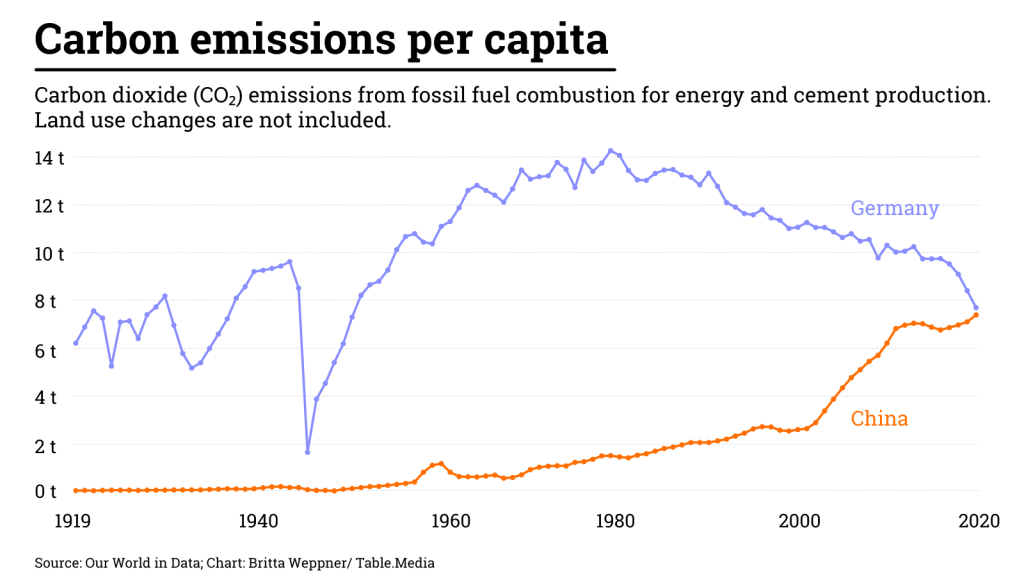
The primary source of financing for the development of the Chinese chip industry stands at the heart of a corruption scandal. The scandal involves not only the administration and the board of directors, but also figures from industry and politics.
The China Integrated Circuit Industry Investment Fund, which was launched in 2014 and is also referred to in industry circles as the “Big Fund” due to its volume and its crucial role in the development of the Chinese chip industry, is a declaration of war from the government on global market leaders and a signal for the move towards independence from unwanted suppliers. China wants to break free from the constraints of having to purchase technological components from the US, Taiwan or South Korea.
To this end, both the Chinese government and powerful state-owned companies such as the China Development Bank have injected the equivalent of more than €50 billion into the fund. Money flowed to numerous companies that today belong to the largest semiconductor companies in China. The domestic top dog SMCI also profited massively from the “Big Fund”.
The first signs that something was afoot already surfaced on July 14. Beijing launched an investigation against the CEO of investment company Sino IC Capital, Lu Jun. He managed the chip fund. Two weeks later, the top anti-corruption authority CCDI then also confirmed an investigation against Ding Wenwu, until then Chairman of the fund. The investigation is based on suspicion of “serious violations of discipline and laws,” a term used to describe allegations of corruption. Since then, at least four other managers have been under investigation.
But not only the leaders of the chip fund have caught the eye of investigators. Late last month, officials in Beijing also launched an investigation into billionaire Zhao Weiguo. Zhao is considered the country’s chip tycoon, one of the pioneers of the future industry. Until recently, he served as head of the major semiconductor manufacturer Tsinghua Unigroup. He was forced to resign in May after his company accumulated more and more debt in recent years and eventually ran into difficulties.
But it is not only the management and the billionaire who are now in trouble. The scandal is also literally becoming a political issue. Xiao Yaqing, China’s Minister of Industry and Information Technology (MIIT), also seems to be caught up in the maelstrom of corruption. His ministry plays a key role in planning the expansion of the chip industry.
Although the authorities have not officially confirmed any connection, the fact that the management of a brimming chip fund and one of the most important entrepreneurs in the industry fell out of favor at the same time suggests that the names are directly connected, but details are not known. The authorities have not officially confirmed any connection. However, no details are known. But the fact that investigations are now underway is also a sign that the generous investment has not yet paid off as Beijing had hoped.
Bloomberg cited unnamed government officials as being “angry” that the many billions Beijing has poured into the industry over the past decade have hardly yielded any technological breakthroughs. The key industry can boast only minor successes.
According to unconfirmed rumors, chip manufacturer SMIC recently achieved a breakthrough in development despite US sanctions. The company reportedly was able to ship chips with a structure width of only seven nanometers for the first time. However, it is doubtful whether the seven-nanometer chips are truly market-ready and can also be produced in large quantities while maintaining high quality. Should this prove to be true, however, the learning curve would be considerable. So far, SMIC has in fact mainly produced in the 14-nanometer segment.
Another problem for China is that in the race for the strongest chip industry, the USA has recently stepped up its own subsidies. Two weeks ago, US President Joe Biden signed the “CHIPS and Science Act” worth around $52 billion. The money is to be used to help US chip giants such as Micron, Intel and AMD keep their Chinese competitors at bay.
Meanwhile, Beijing’s clean-up action also sends a signal to its own industry that greater efforts are needed. As a result, the accused fund managers, as well as Minister Xiao and entrepreneur Zhao, will no longer be involved in the competition with the Americans. Corruption allegations are virtually impossible to refute once they are out in China. Gregor Koppenburg/Joern Petring
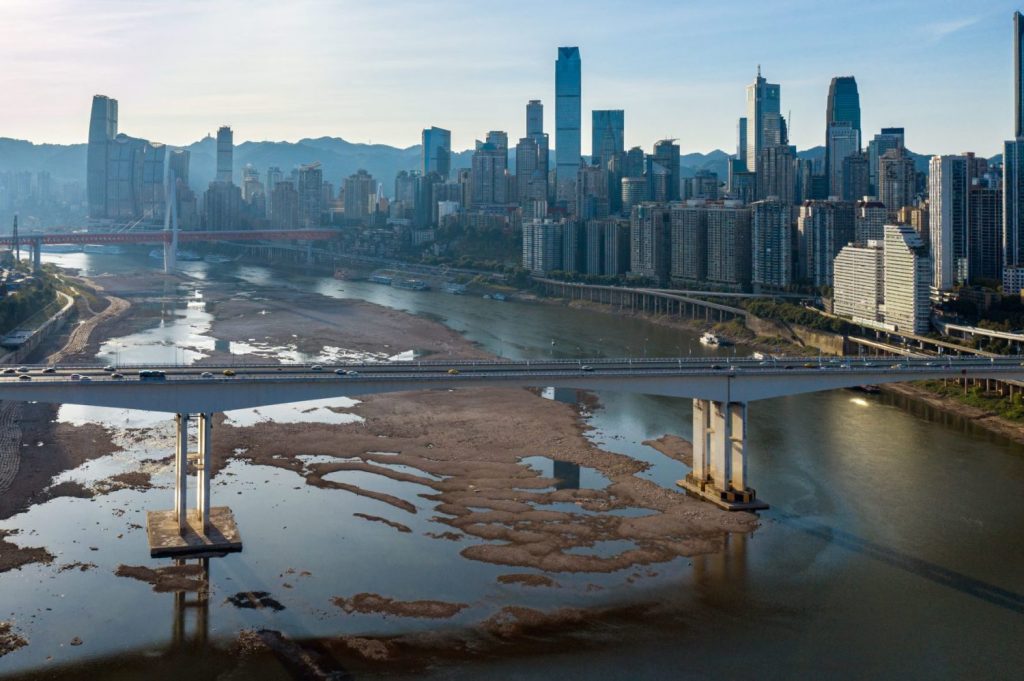
The Yangtze River (Yangzi) is carrying less and less water due to the long drought (China.Table reported). The level in the region’s reservoirs also drops to historic lows. Large amounts of hydropower are usually produced at the dams. As a result, electrical power is becoming scarce in the major metropolis of Chongqing. Shopping malls in Chongqing now have to close for several hours a day to save power.
Factories in the neighboring province of Sichuan have to shut down for the same reason. Important sectors such as manufacturers of semiconductors, solar cells and car parts are also affected. Tesla in Shanghai has already had to cut production due to missing supplies from Sichuan. The province normally meets 80 percent of its electricity needs from hydropower.
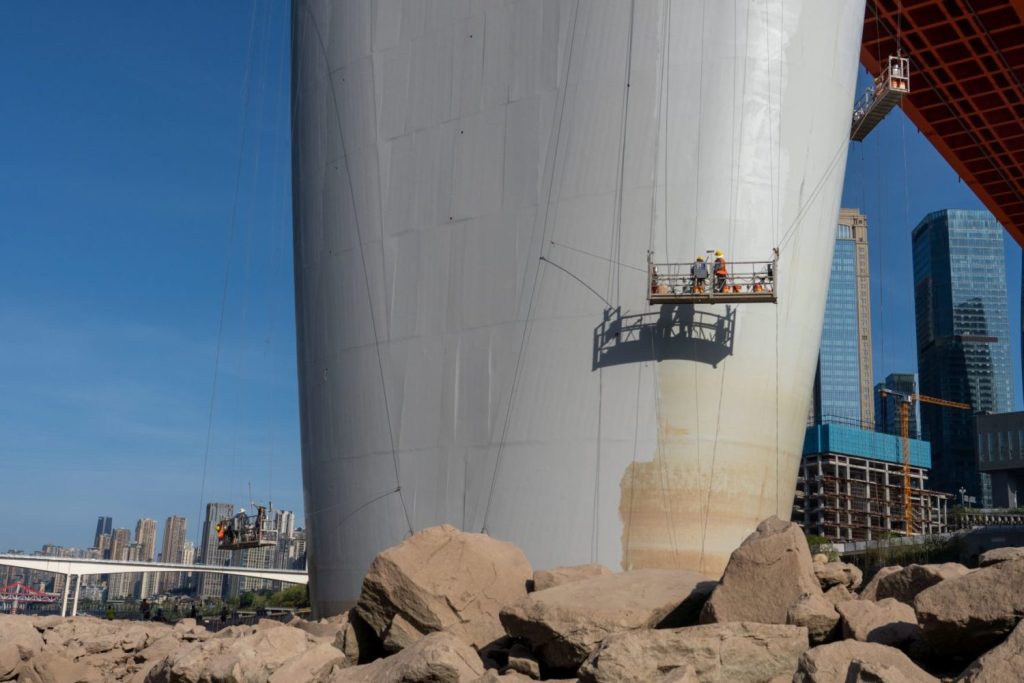
Chongqing currently offers an unusual sight. Like the Rhine in Germany, the mighty Yangtze River has shrunk to the width of a stream. The city is taking the opportunity to freshly paint bridge piers all the way to the bottom. Children play between the stones in the dry riverbed and catch crabs.

The power fluctuations can also be seen far downriver in Shanghai. The illumination spectacle on the Bund is taking a break for a few days to save power. This is part of a city plan to conserve energy. The plan envisions the following mechanism: In the event of a supply shortfall of more than six million kilowatt-hours, the city must ensure a load reduction of 800,000 kilowatts. It must notify all affected electricity customers in a timely manner. fin
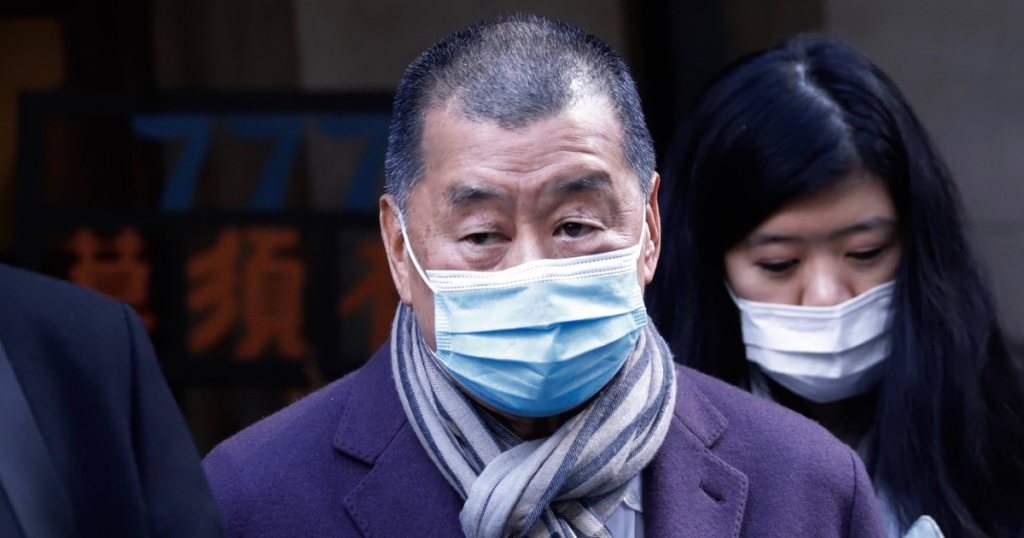
Six high-ranking employees of the defunct Hong Kong daily Apple Daily accept charges of conspiring with foreign forces based on the National Security Law. Only its founder, renowned government critic Jimmy Lai, pleaded not guilty at a public hearing in the city’s High Court on Monday. Prosecutors accuse the seven journalists of openly inciting foreign countries to take sanctions and hostile measures against Hong Kong on July 1, 2020, a day after the security law was introduced.
Media entrepreneur Lai (74) is currently already serving a 13-month prison sentence for attending a memorial service to mark the anniversary of the 1989 Tiananmen Square massacre in Beijing. Should he now also be found guilty of the alleged violation of the National Security Law, despite his plea, he faces up to ten years in prison. His trial will be held separately from that of his six ex-colleagues, the prosecution announced.
The six employees are editor-in-chief Ryan Law, managing editor Lam Man-chung, publisher Cheung Kim-hung, publishing partner Chan Pui-man, and columnists Fung Wai-kong and Yeung Ching-kee. All seven are still under parallel investigation under the Colonial Sedition Act.
Authorities accuse them of conspiracy to have “printed, published, sold, offered for sale, displayed, or reproduced” secessionist publications in 2019. Because the Security Law was not introduced until 2020, prosecutors have unceremoniously revived the Sedition Law. For decades, it had not been applied by the city’s judiciary. The maximum penalty for a first-time conviction is two years in prison and a fine.
The High Court consists of three judges who can be selected by the city’s political leadership through mechanisms for security law violations. Contrary to the usual practice of not holding hearings in public for cases under the Security Law, the judges had allowed the press to attend. grz
China’s central bank plans to help the struggling economy, which has been hit by the real estate and Covid crises, with another interest rate cut. The one-year loan prime rate (LPR) was cut by 5 points to 3.65 percent on Monday, according to a Reuters report. The key rate for five-year loans fell by 15 points to 4.30 percent.
The measures are designed to encourage banks to lend more at cheaper rates and stabilize the property market. Bloomberg reported Monday that China also plans to issue ¥200 billion ($29.3 billion) in special loans to ensure stalled housing projects can be completed and handed over to buyers. In July, tens of thousands of Chinese threatened to stop servicing their mortgages if construction on their homes, halted in the wake of the housing crisis, did not continue. (China.Table reported).
Economists believe that there could be two more interest rate cuts this year. However, the central bank faces a balancing act: It must ensure that inflation is not fueled by an excessively loose monetary policy. At the same time, it must keep an eye on the risk of capital flight, as, for example, dollar investments are becoming increasingly attractive in the US in the wake of aggressive interest rate hikes. A week ago, the Chinese central bank already lowered the interest rate for one-year refinancing transactions with banks in order to increase the banks’ liquidity (China.Table reported).
The Chinese central bank last cut the one year loan prime rate in January and the rate for five-year loans in May. The government’s growth target of 5.5 percent for this year is not expected to be met, partly because consumers are reluctant to spend money. Economists at US investment bank Goldman Sachs expect growth of only 3.0 percent. rts/fpe
Amid growing tensions with China, Taiwan has welcomed another delegation of high-ranking politicians. The group led by Eric J. Holcomb, governor of the US state of Indiana, met Taiwanese President Tsai Ing-wen in Taipei on Monday. “I’m committed to building an economy of the future with these global partners who are helping propel Indiana forward by creating tomorrow’s businesses, today,” the governor’s statement said. Last week, Washington announced plans to launch trade talks with Taiwan this fall, but the talks will be primarily political.
The U.S. and Taiwan “share so many common values and interests and goals,” the governor said. Before leaving again on Wednesday, Holcomb plans to meet with key representatives of Taiwan’s semiconductor industry. His unannounced trip was the second visit by US politicians within a week (China.Table reported). The move suggests that the US wants to make meetings with high-ranking Taiwanese political officials the norm, despite Beijing’s objections.
Three weeks ago, the visit of US House Speaker Nancy Pelosi created massive tensions with China. In response, China’s military held its largest ever military exercises in the waters around the island. fpe

The impressions of his first trip to China have left a lasting impression on Nis Gruenberg. Even today, when he thinks back on it, he is overcome with such intense emotion that the half-Dane is left speechless. “Mindblowing,” the lead analyst of the Berlin research institute Merics told China.Table instead: simply overwhelming. That was 18 years ago, and since then it has become clear to Gruenberg that he wanted to dedicate his career to China, which until then he had only known as an abstract idea from his studies – and he has made good on this promise to himself.
With his research on the Chinese Communist Party, its elite politics and, more recently, increasingly on the sustainable and green transition of the Chinese economy, Gruenberg has long been considered one of the foremost China experts in Germany. He regularly gives interviews to leading media on Chinese politics and the changes the country is undergoing.
They are theoretical questions that Gruenberg would never have thought at the beginning of his studies would one day be a concern for him. In 2003, he began a master’s degree in anthropology at the Free University of Berlin and, rather by chance, came across the People’s Republic in a study catalog. He chooses Chinese studies as his major and begins learning Mandarin. “It suited me,” he quickly discovered. He later went to Copenhagen, and studied Chinese studies, first for a bachelor’s degree and then for a master’s. He then went on to earn a Ph.D.
When he was drawn to the country for the first time in 2004, the idea of China as a future economic power already existed in Germany. But a tangible idea of what the country itself, and also the world, would look like with a powerful People’s Republic was not yet floating around. Only slowly did it become clear what it would mean when a country of this size awakens economically. What kind of consequences this would have for our planet, for example.
The question that currently drives Gruenberg deals with precisely these dimensions: Can China make the energy transition sustainable and efficient? The answer is still open. China does have the advantage of being able to direct resources in one direction very quickly, Gruenberg observes. However, no one can yet predict whether it will be able to achieve the associated cultural change and thus the entire transition to renewable energies.
But Gruenberg’s true passion, as he says, still lies not in the theoretical, but the “exploration of the distant paradise”. Whenever his studies allowed, he would hop on a plane or train to the Far East and travel across the country. As a tour guide, he led Danish tourists through China, securing a visa and free transportation. “I spent most of my twenties in China, even though I never fully moved there,” he recalls. He particularly enjoyed southern China, especially the province of Yunnan.
It is understandable that nothing now pains the 40-year-old more than the strict entry requirements into the country. “The human dimension is completely missing,” he says. ” Here, the very understanding between China and the rest of the world is being lost, the personal and the nuances. This is highly dangerous for mutual cooperation,” he is convinced. Especially since his experiences no longer keep pace with current developments and urgently need to be refreshed. “Back then, I got to know a China that no longer exists today and that students who once studied for six months at an elite university in Shanghai will never get to know,” says Gruenberg.
Because as good as open-source data is for analyzing economic development today, it still cannot replace the human component – the exchange and the question: What really concerns people? Since the beginning of the pandemic, it has been impossible to find out all this. If it were up to Gruenberg, he would immediately get on a plane and tour rural China once again. But for that to happen, the country has to open up. Will that happen again? “I hope so,” Gruenberg says. Nils Wischmeyer
Shang Xu has taken over as Director Head of Holistic New Technology at VW China. Xu previously spent three years helping to shape the automaker’s battery strategy in China. In his new position, he is responsible for the supply chain and procurement strategy of high-voltage batteries, semiconductors, raw materials, and the fields of connectivity and infotainment.
Sebastian Mueller has been Head of Business Development & Strategy at Bosch China in Shanghai and Suzhou since July. His responsibilities include corporate and strategic development, management of strategic partnerships, and innovation development in the field of automotive electronics (ECU & semiconductors).
Is something changing in your organization? Why not let us know at heads@table.media!

Harvest time for the fruits of the Chinese berry grape (Schisandra chinensis): The medicinal plant, which is harvested in summer, provides ingredients for the production of Traditional Chinese Medicine (TCM). The Chinese government has been promoting the marketing of TCM products for several years. The desired side effect is an economic stimulus for rural regions of the country.
In today’s Profile, Merics researcher Nis Gruenberg talks about a vision from 2004 of what the future might look like if China was an economic power – an abstract idea at the time. 18 years later, that vision is now taking shape. Politically, however, increasingly sharp lines of conflict are emerging in the wake of China’s growing significance. These have the potential to tear open wounds that could destroy global peace.
And yet, governments are doomed to work closely together in this constellation. Namely, when it comes to the fight against global warming. If the climate tips over the critical threshold, there will only be losers anyway. However, countries wait and see what price the others are willing to pay in the form of declining economic growth.
In China, this tactic has a special dimension because the government has to reconcile growth with environmental and climate protection more urgently than in other countries, as Nico Beckert reports. If growth is curbed too much, social divisions threaten the rule of the CP. If too much carbon continues to be blown into the air, the climate will heat up even more. Extreme weather such as heat waves, floods and droughts would deprive China of its livelihoods. Harvests would be endangered and protests could be expected because the government failed to protect the people from disaster.
The recent past has already shown that political stability takes precedence over climate protection in China. What this means for the world is only an abstract idea today. But we will probably have a much more concrete idea of the consequences in 18 years’ time.

After last year’s coal crisis, climate change strikes this year and affects the power supply in some Chinese provinces. Factories are at a standstill, crops are at risk, and tens of millions of people are suffering under heat that can last for weeks (China.Table reported). Beijing leaders are facing one of the biggest challenges of the 21st century: How to reduce the massive carbon emissions of the Chinese economy without jeopardizing economic growth and jobs.
The lfW event “Green Growth: What can we expect from China?” explored this question. It quickly became clear what a dilemma the government is in: China must reconcile growth with environmental and climate protection. If growth is curbed too much, social divisions will threaten the rule of the CP. If too much carbon dioxide continues to be blown into the air, the climate will heat up even more. Extreme weather such as heat waves, floods and droughts would deprive China of its livelihoods. Harvests would be endangered and protests could be expected because the government failed to protect the people from disaster.
This poses a challenge for the People’s Republic to quickly decouple growth from carbon emissions, says Sebastian Eckardt, an economist at the World Bank. No country in history has had to transform its economy as quickly as China must now. Continued consumption of coal and other fossil fuels would plunge the world into climate chaos.

Eckardt sees two major problems here. First, he says, it is still difficult to reduce emissions in some industrial sectors – especially cement, iron and steel. According to Eckhardt, the necessary low-carbon production technologies are simply not yet available. Which has all the more impact on the climate because China’s industrial sector emits far more than either the US or the EU. Here, China could benefit from the fact that demand for construction raw materials will fall in the coming years, according to the World Bank expert. Other analysts assume that a lot of carbon dioxide can be saved in the next few years through scrap metal recycling (China.Table reported).
A second pressing problem is the social issue of decarbonization. According to various estimates, up to five million people work in coal production. The construction sector employs between 54 and 60 million people (China.Table reported). Should these jobs disappear, China’s social stability could be shaken. This is because, according to World Bank economist Eckardt, a switch to clean energy would primarily hurt unskilled, male workers. Getting these workers into new jobs poses immense challenges for the government. Regional inequality could rise sharply. After all, the necessary social systems to cushion unemployment are still lacking.
But how does China plan to cut its emissions? By 2030, the country will focus primarily on improving energy efficiency, says Xiliang Zhang, the Director of the Institute of Energy, Environment and Economics at Tsinghua University. By building more modern production facilities while simultaneously shutting down older coal-fired power plants, emissions are expected to be reduced. In the period between 2030 and 2050, replacing fossil fuels with renewables will have a major impact on China’s decarbonization. According to analysts, this is also urgently needed. To achieve the climate targets and eliminate coal-fired power from the energy mix, renewable energy sources such as wind and solar will have to be expanded even faster.
According to Zhang, China will also rely more heavily on carbon capture technologies from 2036. Processes such as cement production, in which carbon emissions have so far been difficult to prevent, are thus set to become carbon-neutral. In the last 10 years before the goal of carbon neutrality is reached (by 2060), carbon capture technologies are expected to contribute as much as 70 percent to reducing emissions. However, the process of direct air capture, the direct extraction of carbon dioxide from the air, is not expected to be widely utilized until 2060. At present, much of this is still a long way off, as investment in carbon capture technologies is still very low, even in China (China.Table reported).
China is now responsible for a good 30 percent of annual global carbon emissions. Per capita emissions in the People’s Republic are now at a similar level as in Germany. If the global community wants to achieve its climate targets, China has to make a significant contribution. This is also in Beijing’s interest. After all, climate change has long since become part of people’s everyday lives – this year, they are suffering under extreme temperatures of over 40 degrees in some places. Last year, torrential rain caused widespread flooding. In a system like China’s, the state is held even more responsible for these extremes than in the West. Climate change is therefore also likely to become one of the top priorities of the Chinese Communist Party in the years to come.

The primary source of financing for the development of the Chinese chip industry stands at the heart of a corruption scandal. The scandal involves not only the administration and the board of directors, but also figures from industry and politics.
The China Integrated Circuit Industry Investment Fund, which was launched in 2014 and is also referred to in industry circles as the “Big Fund” due to its volume and its crucial role in the development of the Chinese chip industry, is a declaration of war from the government on global market leaders and a signal for the move towards independence from unwanted suppliers. China wants to break free from the constraints of having to purchase technological components from the US, Taiwan or South Korea.
To this end, both the Chinese government and powerful state-owned companies such as the China Development Bank have injected the equivalent of more than €50 billion into the fund. Money flowed to numerous companies that today belong to the largest semiconductor companies in China. The domestic top dog SMCI also profited massively from the “Big Fund”.
The first signs that something was afoot already surfaced on July 14. Beijing launched an investigation against the CEO of investment company Sino IC Capital, Lu Jun. He managed the chip fund. Two weeks later, the top anti-corruption authority CCDI then also confirmed an investigation against Ding Wenwu, until then Chairman of the fund. The investigation is based on suspicion of “serious violations of discipline and laws,” a term used to describe allegations of corruption. Since then, at least four other managers have been under investigation.
But not only the leaders of the chip fund have caught the eye of investigators. Late last month, officials in Beijing also launched an investigation into billionaire Zhao Weiguo. Zhao is considered the country’s chip tycoon, one of the pioneers of the future industry. Until recently, he served as head of the major semiconductor manufacturer Tsinghua Unigroup. He was forced to resign in May after his company accumulated more and more debt in recent years and eventually ran into difficulties.
But it is not only the management and the billionaire who are now in trouble. The scandal is also literally becoming a political issue. Xiao Yaqing, China’s Minister of Industry and Information Technology (MIIT), also seems to be caught up in the maelstrom of corruption. His ministry plays a key role in planning the expansion of the chip industry.
Although the authorities have not officially confirmed any connection, the fact that the management of a brimming chip fund and one of the most important entrepreneurs in the industry fell out of favor at the same time suggests that the names are directly connected, but details are not known. The authorities have not officially confirmed any connection. However, no details are known. But the fact that investigations are now underway is also a sign that the generous investment has not yet paid off as Beijing had hoped.
Bloomberg cited unnamed government officials as being “angry” that the many billions Beijing has poured into the industry over the past decade have hardly yielded any technological breakthroughs. The key industry can boast only minor successes.
According to unconfirmed rumors, chip manufacturer SMIC recently achieved a breakthrough in development despite US sanctions. The company reportedly was able to ship chips with a structure width of only seven nanometers for the first time. However, it is doubtful whether the seven-nanometer chips are truly market-ready and can also be produced in large quantities while maintaining high quality. Should this prove to be true, however, the learning curve would be considerable. So far, SMIC has in fact mainly produced in the 14-nanometer segment.
Another problem for China is that in the race for the strongest chip industry, the USA has recently stepped up its own subsidies. Two weeks ago, US President Joe Biden signed the “CHIPS and Science Act” worth around $52 billion. The money is to be used to help US chip giants such as Micron, Intel and AMD keep their Chinese competitors at bay.
Meanwhile, Beijing’s clean-up action also sends a signal to its own industry that greater efforts are needed. As a result, the accused fund managers, as well as Minister Xiao and entrepreneur Zhao, will no longer be involved in the competition with the Americans. Corruption allegations are virtually impossible to refute once they are out in China. Gregor Koppenburg/Joern Petring

The Yangtze River (Yangzi) is carrying less and less water due to the long drought (China.Table reported). The level in the region’s reservoirs also drops to historic lows. Large amounts of hydropower are usually produced at the dams. As a result, electrical power is becoming scarce in the major metropolis of Chongqing. Shopping malls in Chongqing now have to close for several hours a day to save power.
Factories in the neighboring province of Sichuan have to shut down for the same reason. Important sectors such as manufacturers of semiconductors, solar cells and car parts are also affected. Tesla in Shanghai has already had to cut production due to missing supplies from Sichuan. The province normally meets 80 percent of its electricity needs from hydropower.

Chongqing currently offers an unusual sight. Like the Rhine in Germany, the mighty Yangtze River has shrunk to the width of a stream. The city is taking the opportunity to freshly paint bridge piers all the way to the bottom. Children play between the stones in the dry riverbed and catch crabs.

The power fluctuations can also be seen far downriver in Shanghai. The illumination spectacle on the Bund is taking a break for a few days to save power. This is part of a city plan to conserve energy. The plan envisions the following mechanism: In the event of a supply shortfall of more than six million kilowatt-hours, the city must ensure a load reduction of 800,000 kilowatts. It must notify all affected electricity customers in a timely manner. fin

Six high-ranking employees of the defunct Hong Kong daily Apple Daily accept charges of conspiring with foreign forces based on the National Security Law. Only its founder, renowned government critic Jimmy Lai, pleaded not guilty at a public hearing in the city’s High Court on Monday. Prosecutors accuse the seven journalists of openly inciting foreign countries to take sanctions and hostile measures against Hong Kong on July 1, 2020, a day after the security law was introduced.
Media entrepreneur Lai (74) is currently already serving a 13-month prison sentence for attending a memorial service to mark the anniversary of the 1989 Tiananmen Square massacre in Beijing. Should he now also be found guilty of the alleged violation of the National Security Law, despite his plea, he faces up to ten years in prison. His trial will be held separately from that of his six ex-colleagues, the prosecution announced.
The six employees are editor-in-chief Ryan Law, managing editor Lam Man-chung, publisher Cheung Kim-hung, publishing partner Chan Pui-man, and columnists Fung Wai-kong and Yeung Ching-kee. All seven are still under parallel investigation under the Colonial Sedition Act.
Authorities accuse them of conspiracy to have “printed, published, sold, offered for sale, displayed, or reproduced” secessionist publications in 2019. Because the Security Law was not introduced until 2020, prosecutors have unceremoniously revived the Sedition Law. For decades, it had not been applied by the city’s judiciary. The maximum penalty for a first-time conviction is two years in prison and a fine.
The High Court consists of three judges who can be selected by the city’s political leadership through mechanisms for security law violations. Contrary to the usual practice of not holding hearings in public for cases under the Security Law, the judges had allowed the press to attend. grz
China’s central bank plans to help the struggling economy, which has been hit by the real estate and Covid crises, with another interest rate cut. The one-year loan prime rate (LPR) was cut by 5 points to 3.65 percent on Monday, according to a Reuters report. The key rate for five-year loans fell by 15 points to 4.30 percent.
The measures are designed to encourage banks to lend more at cheaper rates and stabilize the property market. Bloomberg reported Monday that China also plans to issue ¥200 billion ($29.3 billion) in special loans to ensure stalled housing projects can be completed and handed over to buyers. In July, tens of thousands of Chinese threatened to stop servicing their mortgages if construction on their homes, halted in the wake of the housing crisis, did not continue. (China.Table reported).
Economists believe that there could be two more interest rate cuts this year. However, the central bank faces a balancing act: It must ensure that inflation is not fueled by an excessively loose monetary policy. At the same time, it must keep an eye on the risk of capital flight, as, for example, dollar investments are becoming increasingly attractive in the US in the wake of aggressive interest rate hikes. A week ago, the Chinese central bank already lowered the interest rate for one-year refinancing transactions with banks in order to increase the banks’ liquidity (China.Table reported).
The Chinese central bank last cut the one year loan prime rate in January and the rate for five-year loans in May. The government’s growth target of 5.5 percent for this year is not expected to be met, partly because consumers are reluctant to spend money. Economists at US investment bank Goldman Sachs expect growth of only 3.0 percent. rts/fpe
Amid growing tensions with China, Taiwan has welcomed another delegation of high-ranking politicians. The group led by Eric J. Holcomb, governor of the US state of Indiana, met Taiwanese President Tsai Ing-wen in Taipei on Monday. “I’m committed to building an economy of the future with these global partners who are helping propel Indiana forward by creating tomorrow’s businesses, today,” the governor’s statement said. Last week, Washington announced plans to launch trade talks with Taiwan this fall, but the talks will be primarily political.
The U.S. and Taiwan “share so many common values and interests and goals,” the governor said. Before leaving again on Wednesday, Holcomb plans to meet with key representatives of Taiwan’s semiconductor industry. His unannounced trip was the second visit by US politicians within a week (China.Table reported). The move suggests that the US wants to make meetings with high-ranking Taiwanese political officials the norm, despite Beijing’s objections.
Three weeks ago, the visit of US House Speaker Nancy Pelosi created massive tensions with China. In response, China’s military held its largest ever military exercises in the waters around the island. fpe

The impressions of his first trip to China have left a lasting impression on Nis Gruenberg. Even today, when he thinks back on it, he is overcome with such intense emotion that the half-Dane is left speechless. “Mindblowing,” the lead analyst of the Berlin research institute Merics told China.Table instead: simply overwhelming. That was 18 years ago, and since then it has become clear to Gruenberg that he wanted to dedicate his career to China, which until then he had only known as an abstract idea from his studies – and he has made good on this promise to himself.
With his research on the Chinese Communist Party, its elite politics and, more recently, increasingly on the sustainable and green transition of the Chinese economy, Gruenberg has long been considered one of the foremost China experts in Germany. He regularly gives interviews to leading media on Chinese politics and the changes the country is undergoing.
They are theoretical questions that Gruenberg would never have thought at the beginning of his studies would one day be a concern for him. In 2003, he began a master’s degree in anthropology at the Free University of Berlin and, rather by chance, came across the People’s Republic in a study catalog. He chooses Chinese studies as his major and begins learning Mandarin. “It suited me,” he quickly discovered. He later went to Copenhagen, and studied Chinese studies, first for a bachelor’s degree and then for a master’s. He then went on to earn a Ph.D.
When he was drawn to the country for the first time in 2004, the idea of China as a future economic power already existed in Germany. But a tangible idea of what the country itself, and also the world, would look like with a powerful People’s Republic was not yet floating around. Only slowly did it become clear what it would mean when a country of this size awakens economically. What kind of consequences this would have for our planet, for example.
The question that currently drives Gruenberg deals with precisely these dimensions: Can China make the energy transition sustainable and efficient? The answer is still open. China does have the advantage of being able to direct resources in one direction very quickly, Gruenberg observes. However, no one can yet predict whether it will be able to achieve the associated cultural change and thus the entire transition to renewable energies.
But Gruenberg’s true passion, as he says, still lies not in the theoretical, but the “exploration of the distant paradise”. Whenever his studies allowed, he would hop on a plane or train to the Far East and travel across the country. As a tour guide, he led Danish tourists through China, securing a visa and free transportation. “I spent most of my twenties in China, even though I never fully moved there,” he recalls. He particularly enjoyed southern China, especially the province of Yunnan.
It is understandable that nothing now pains the 40-year-old more than the strict entry requirements into the country. “The human dimension is completely missing,” he says. ” Here, the very understanding between China and the rest of the world is being lost, the personal and the nuances. This is highly dangerous for mutual cooperation,” he is convinced. Especially since his experiences no longer keep pace with current developments and urgently need to be refreshed. “Back then, I got to know a China that no longer exists today and that students who once studied for six months at an elite university in Shanghai will never get to know,” says Gruenberg.
Because as good as open-source data is for analyzing economic development today, it still cannot replace the human component – the exchange and the question: What really concerns people? Since the beginning of the pandemic, it has been impossible to find out all this. If it were up to Gruenberg, he would immediately get on a plane and tour rural China once again. But for that to happen, the country has to open up. Will that happen again? “I hope so,” Gruenberg says. Nils Wischmeyer
Shang Xu has taken over as Director Head of Holistic New Technology at VW China. Xu previously spent three years helping to shape the automaker’s battery strategy in China. In his new position, he is responsible for the supply chain and procurement strategy of high-voltage batteries, semiconductors, raw materials, and the fields of connectivity and infotainment.
Sebastian Mueller has been Head of Business Development & Strategy at Bosch China in Shanghai and Suzhou since July. His responsibilities include corporate and strategic development, management of strategic partnerships, and innovation development in the field of automotive electronics (ECU & semiconductors).
Is something changing in your organization? Why not let us know at heads@table.media!

Harvest time for the fruits of the Chinese berry grape (Schisandra chinensis): The medicinal plant, which is harvested in summer, provides ingredients for the production of Traditional Chinese Medicine (TCM). The Chinese government has been promoting the marketing of TCM products for several years. The desired side effect is an economic stimulus for rural regions of the country.
